FACILITIES OF REGION 3 - ANNE
Download as PPTX, PDF3 likes434 views
Region III has good transportation infrastructure like highways, airports, and ports facilitating trade. It has adequate electricity, water, markets, recreational facilities, education, and financial institutions. The region covers 2.1 million hectares, with 41% agricultural land growing rice and other crops. Forest land makes up 43.89% of the area, located mostly in Aurora and Zambales. Community-based forest management programs have placed over 66,000 hectares under community stewardship, benefiting over 10,000 households. Reforestation programs have planted over 15,000 hectares of trees.
1 of 9
Download to read offline
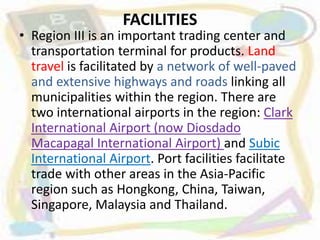


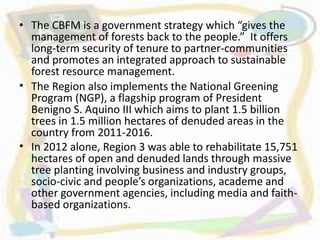





Recommended
Human environment



Human environmentananyasharma833350
Ěý
This document discusses different types of human settlements and transportation and communication networks. It describes how settlements are classified as temporary or permanent depending on their purpose and layout. Rural settlements tend to be smaller with limited services, while urban settlements are centers of non-agricultural activities. The relationship between rural and urban areas is one of interdependence. The document also outlines various transportation networks like roads, railways, waterways and airways used to move people and goods. It provides examples of major transportation infrastructure around the world and how communication technologies have reduced physical distances.Carters Creek Condos at Associates Avenue



Carters Creek Condos at Associates AvenueCity of College Station
Ěý
This document discusses a comprehensive plan amendment for Carter's Creek Condos located at 1451 Associates Ave. The plan proposes changing the land use designation from Natural Areas Reserved to Urban to allow for more intense development like townhomes, duplexes, and high-density apartments consistent with an urban land use.Harvey Mitchell Parkway Comp Plan Amendment



Harvey Mitchell Parkway Comp Plan AmendmentCity of College Station
Ěý
The document discusses a comprehensive plan amendment for a campus housing project located at 404 Harvey Mitchell Parkway. The current zoning and land use designations for the area include Natural Areas Reserved, Natural Areas Protected, General Commercial, Suburban Commercial, Medical Use/Institutional/Public, Business Park, Urban, General Suburban, Neighborhood Conservation, Village Center, Rural, Commercial, Industrial, and General Commercial designations related to Texas A&M University.ROLES OF FAMILY - ANNE



ROLES OF FAMILY - ANNEAnne Elmido
Ěý
The document discusses the roles and responsibilities of family members at different stages of the family life cycle. It begins by outlining traditional roles like the father providing for the family financially and making major decisions, and the mother caring for the home and children. As the family expands with children, roles change to focus on parenting, education, and caregiving responsibilities. Challenges occur at each stage as family structures and needs change, from the beginning family forming their unit to empty nest stages when children have grown and left home. Not all families strictly follow the stages or have the same traditional nuclear structure.Roles and responsibilities of each family member



Roles and responsibilities of each family memberEddie Abug
Ěý
This document discusses the roles and responsibilities of family members. It begins by defining role as one's position in a group, while responsibilities are the obligations that come with that role. Traditionally, the father's role was sole breadwinner, while the mother stayed home for housekeeping and childcare. However, roles have adjusted over time, with both parents often working today. The document then outlines traditional roles of brothers and sisters, with older children sometimes helping with tasks. It emphasizes the importance of Filipino families staying close together through difficulties.Family Members: Roles and responsibilities



Family Members: Roles and responsibilitiesjanet25
Ěý
The document discusses the duties and responsibilities of family members to maintain peace and harmony in the home. Traditionally, the father's role was to be the breadwinner, while the mother managed finances and household tasks. Girls helped with chores, while boys did heavy work. Nowadays, responsibilities are shared more equally between all family members. Creating a schedule can help ensure everyone participates in homemaking duties during free time. Fulfilling expected roles leads to family harmony.Proposed disaster resilient greenhouse corn farm facility in ilocos region



Proposed disaster resilient greenhouse corn farm facility in ilocos regionAlvin Jhon Ogena
Ěý
This document discusses a proposed disaster resilient greenhouse corn farm facility in Ilocos Region to enhance corn production through the adaptation of science and technology. It would include various buildings and facilities like a culture testing greenhouse, laboratory, storage, drying and post-harvest facilities. The proposed site is in San Carlos City. The project proponents include the local government unit and government agencies like the Department of Agriculture and Department of Science and Technology. Estimated costs include PHP 650 million for land acquisition, PHP 1.67 billion for building facilities, and PHP 273 million for site development. Funding sources and implementation mechanisms are also proposed.Strategies for metropolitan planning



Strategies for metropolitan planningASRufai
Ěý
Delhi is the second most populated city in India with over 16 million people. It faces many problems related to unplanned development, lack of public participation, inadequate infrastructure, and environmental issues. The strategies outlined in the document propose decentralized local area planning, performance-oriented development focused on implementation, increasing public participation, planned redevelopment along transport corridors, increasing housing supply through group housing and PPPS, improving disaster management and the environment, regulating mixed-use development, developing trade centers, and enhancing infrastructure for health, education, and sports.Rdt-Agenda.pdf



Rdt-Agenda.pdfLeiExcelPacatang
Ěý
The document outlines a regional development agenda for Zamboanga Peninsula in the Philippines. The agenda focuses on economic development through agriculture, fisheries and industry. It also addresses infrastructure, human capital development, environment protection and peace/security. The plan aims to make Zamboanga Peninsula a major economic player through agribusiness, aquaculture, tourism and its strategic location as a gateway to Southeast Asia.Land-Use Planning



Land-Use PlanningFloreva Reyes
Ěý
Historically, land use patterns were shaped by factors like transportation corridors along waterways and the industrial revolution driving rural to urban migration. Over time, problems arose from unplanned growth such as loss of agricultural land, transportation issues, and lack of open space. Effective land use planning involves assessing an area's unique features, projecting needs, and developing implementation strategies to balance competing uses while protecting valuable resources and environments. National policies aim to manage public lands for multiple sustainable uses.Land 601 f15 burgeoning.1.0



Land 601 f15 burgeoning.1.0Macharia Waruingi, MD, DHA
Ěý
The document presents a landscape architectural design project for a proposed Medical Industrial City in Nakuru, Kenya. A student team from Texas A&M University proposes a master plan for the city that includes (1) a medical campus with hospitals and research centers, (2) a residential community with housing and schools, (3) an industrial park for biomedical production, and (4) recreational areas, following principles of healthy living, ecological integrity, and sustainable development. The team's concept plan focuses on connecting these uses with green space and prioritizing pedestrian access. The master plan layouts out the different land uses and includes plans for transportation networks, phasing, and green infrastructure.Analysis of Current Infrastructure and Emerging Trends of Information and Com...



Analysis of Current Infrastructure and Emerging Trends of Information and Com...Dr. Amarjeet Singh
Ěý
In this era of growing technologies, the internet
and the information and communication technologies are
not only the precursor of communication architecture but it
is also the technology of production and social organisation,
which has a pivot role in redesigning the social, economical,
public and political aspects. Today, the term information
technology incorporates many aspects of computing and
technology like software applications, computer networks
and information databases. When the computer and the
communication are combined then it becomes the ICT.
Presently, ICT infrastructure in the IHR is not in a good
condition but nowadays, various new ICT technologies are
emerging day by day through which ICT infrastructure
could be upgraded in the remote areas of the IHR. ICT can
play a significant role in development of the IHR and its
peoples trough communication and internet technologies.Categories of landuse



Categories of landuseProf. A.Balasubramanian
Ěý
Landuse is an emerging socio-economic activity wherein a region of one major specific purpose utility may be converted into another land for general purpose utility. The categories of landuse are highlighted in this module.zdp f revised.pptx



zdp f revised.pptxPushpakBhagwati1
Ěý
Zone F is a large zone in Delhi with a high proportion of recreational land use like parks. It has many prestigious medical and educational institutions. It contains posh residential areas alongside government housing complexes. Being near Lutyens Delhi, it also has major public facilities. The zone aims to preserve urban heritage in Mehrauli and redevelop congested areas through urban renewal schemes. It contains Delhi's largest industrial area in Okhla and is planned to have more commercial centers.Land resource in kenya case for agriculture



Land resource in kenya case for agriculturePETER NAIBEI
Ěý
1. The document discusses land resources and agricultural land use in Kenya. It provides context on how land is viewed differently by farmers, pastoralists, and elites.
2. It then defines key terms related to agriculture and provides classifications of agricultural land according to the FAO.
3. The current agriculture situation in Kenya is described, noting that only 15-17% of land is suitable for farming and agriculture accounts for over 50% of GDP but most farmers lack basic inputs and technology.Architecture and town planning _Unit 3_SPPU_Town planning and various levels ...



Architecture and town planning _Unit 3_SPPU_Town planning and various levels ...Shrikant Kate
Ěý
• Goals and Objectives of planning; components of planning; benefits of planning.
• Levels of planning: Regional plan, Development Plan, Town Planning Scheme.
• Neighborhood plan; Types of Development plans: Master Plan, City Development Plan,
Structure Plan.Carmona Cavite Comprehensive Land Use Planning



Carmona Cavite Comprehensive Land Use PlanningShayne Galo
Ěý
The document provides a comprehensive land use program for Carmona over the next 10 years. It summarizes key points regarding demographics, services, infrastructure, environment, and a proposed spatial strategy. Some highlights include:
- The population is projected to continue growing at under 7% annually, requiring expansion of housing, education, health and other facilities.
- Additional land is needed for schools, hospitals, daycare centers, sports facilities and ecological preservation.
- Infrastructure upgrades like roads, bridges, drainage and utilities also require further development and investment.
- A multi-nodal growth strategy is proposed to concentrate development around existing urban centers and introduce new commercial and eco-tourism zones to accommodate future growthNeeds Analysis



Needs AnalysisPauContreras9
Ěý
This document provides demographic and infrastructure data for Iloilo City and Bacolod City in the Philippines. For Iloilo City, it outlines population trends and density, as well as transportation infrastructure like roads, airports, seaports, and telecommunications networks. It also discusses facilities for solid waste management, agriculture, power, water and the city's economic structure focused on services. For Bacolod City, similar data is presented on demographics, transportation infrastructure including roads and an airport, seaports, solid waste management, agriculture areas and facilities for power, water and telecommunications. Both cities' roles are summarized as regional centers with Iloilo City focusing on governance, finance, commerce, education and logistics andLand use and zoning of mysore



Land use and zoning of mysoreJithu Radhakrishnan
Ěý
This document provides information on land use and zoning in District 12 of Mysore, India. It outlines that:
- District 12 lies in the core of Mysore city and is predominantly residential, with major commercial areas along roads like JBL road.
- As of the existing scenario, residential land makes up 43.45% of the total developed area on the district, while commercial is 2.45%, industrial is 13.22%, and other uses like parks, public/semi-public, and transportation make up the remaining portions.
- The proposed land use plan for 2031 forecasts changes like a decrease in residential area but increases in commercial, parks/open spaces, and public/semi-Afghanistan infrastructure.pptx



Afghanistan infrastructure.pptxsaidabdulbasitpacha
Ěý
The document provides information about Afghanistan's infrastructure, including its transportation systems such as roads and airports. It notes that Afghanistan is a landlocked country located in central Asia, and has a population of over 40 million people. The document discusses some of the challenges facing Afghanistan's infrastructure, such as decades of war damaging roads and facilities. It also outlines suggestions for improving transportation and transit across borders to boost economic growth. Natural disasters that impact infrastructure like earthquakes are also summarized.Town/ city planning development engineering ppt



Town/ city planning development engineering pptashleshag01
Ěý
Town and urban planning Development engineering ppt YUVA2015



YUVA2015Citizens for Accountable Governance
Ěý
The document discusses the growth potential of India's North East region. It outlines several problems facing the region, including civil conflict, limited connectivity, lack of political leadership, unemployment, poor infrastructure, and scanty media coverage. It then proposes several solutions like developing agriculture, improving transportation infrastructure, harnessing hydroelectric power, implementing the Look East policy, and private sector involvement. Realizing the full economic potential of the region faces challenges but would boost India's GDP and bring socio-economic prosperity through increased connectivity, trade, and development.Development control regulations kochi report



Development control regulations kochi reportGeeva Chandana
Ěý
The document summarizes the development control regulations for the Kochi City Region in Kerala, India. It provides an overview of the planning area and divisions, estimated future land requirements, development concepts and strategies, land use categories and regulations, and transport proposals. Key points include that the planning area covers Kochi city and surrounding areas, there is a need for more recreational, commercial, and transportation lands, and the goal is to develop Kochi as a global city with diversified industries and improved regional transport links.ARWAI CALVIN PROPOSAL



ARWAI CALVIN PROPOSALCALVIN ARWAI
Ěý
Starch Factory Ward is a densely populated area located in Lira, Uganda that lacks proper physical development planning. The area experienced rapid population growth due to a starch processing factory established in the 1960s. This led to poor waste management, inadequate infrastructure like roads and drainage, and uncoordinated development with buildings encroaching on road reserves. The preparation of a physical development plan for Starch Factory Ward will help address these issues by organizing land uses, ensuring all plots are accessible, and promoting sustainable development through 2023.Sustainable Land Development



Sustainable Land DevelopmentAsz My
Ěý
This document discusses sustainable land use and development. It defines key concepts like social, economic and environmental sustainability. It discusses challenges like pollution, deforestation and their impacts. It also outlines principles of sustainable land use like compact development, mixed uses, reuse of infrastructure, and open spaces. Overall the document provides an overview of achieving balanced development that considers social, economic and environmental factors.More Related Content
Similar to FACILITIES OF REGION 3 - ANNE (20)
Rdt-Agenda.pdf



Rdt-Agenda.pdfLeiExcelPacatang
Ěý
The document outlines a regional development agenda for Zamboanga Peninsula in the Philippines. The agenda focuses on economic development through agriculture, fisheries and industry. It also addresses infrastructure, human capital development, environment protection and peace/security. The plan aims to make Zamboanga Peninsula a major economic player through agribusiness, aquaculture, tourism and its strategic location as a gateway to Southeast Asia.Land-Use Planning



Land-Use PlanningFloreva Reyes
Ěý
Historically, land use patterns were shaped by factors like transportation corridors along waterways and the industrial revolution driving rural to urban migration. Over time, problems arose from unplanned growth such as loss of agricultural land, transportation issues, and lack of open space. Effective land use planning involves assessing an area's unique features, projecting needs, and developing implementation strategies to balance competing uses while protecting valuable resources and environments. National policies aim to manage public lands for multiple sustainable uses.Land 601 f15 burgeoning.1.0



Land 601 f15 burgeoning.1.0Macharia Waruingi, MD, DHA
Ěý
The document presents a landscape architectural design project for a proposed Medical Industrial City in Nakuru, Kenya. A student team from Texas A&M University proposes a master plan for the city that includes (1) a medical campus with hospitals and research centers, (2) a residential community with housing and schools, (3) an industrial park for biomedical production, and (4) recreational areas, following principles of healthy living, ecological integrity, and sustainable development. The team's concept plan focuses on connecting these uses with green space and prioritizing pedestrian access. The master plan layouts out the different land uses and includes plans for transportation networks, phasing, and green infrastructure.Analysis of Current Infrastructure and Emerging Trends of Information and Com...



Analysis of Current Infrastructure and Emerging Trends of Information and Com...Dr. Amarjeet Singh
Ěý
In this era of growing technologies, the internet
and the information and communication technologies are
not only the precursor of communication architecture but it
is also the technology of production and social organisation,
which has a pivot role in redesigning the social, economical,
public and political aspects. Today, the term information
technology incorporates many aspects of computing and
technology like software applications, computer networks
and information databases. When the computer and the
communication are combined then it becomes the ICT.
Presently, ICT infrastructure in the IHR is not in a good
condition but nowadays, various new ICT technologies are
emerging day by day through which ICT infrastructure
could be upgraded in the remote areas of the IHR. ICT can
play a significant role in development of the IHR and its
peoples trough communication and internet technologies.Categories of landuse



Categories of landuseProf. A.Balasubramanian
Ěý
Landuse is an emerging socio-economic activity wherein a region of one major specific purpose utility may be converted into another land for general purpose utility. The categories of landuse are highlighted in this module.zdp f revised.pptx



zdp f revised.pptxPushpakBhagwati1
Ěý
Zone F is a large zone in Delhi with a high proportion of recreational land use like parks. It has many prestigious medical and educational institutions. It contains posh residential areas alongside government housing complexes. Being near Lutyens Delhi, it also has major public facilities. The zone aims to preserve urban heritage in Mehrauli and redevelop congested areas through urban renewal schemes. It contains Delhi's largest industrial area in Okhla and is planned to have more commercial centers.Land resource in kenya case for agriculture



Land resource in kenya case for agriculturePETER NAIBEI
Ěý
1. The document discusses land resources and agricultural land use in Kenya. It provides context on how land is viewed differently by farmers, pastoralists, and elites.
2. It then defines key terms related to agriculture and provides classifications of agricultural land according to the FAO.
3. The current agriculture situation in Kenya is described, noting that only 15-17% of land is suitable for farming and agriculture accounts for over 50% of GDP but most farmers lack basic inputs and technology.Architecture and town planning _Unit 3_SPPU_Town planning and various levels ...



Architecture and town planning _Unit 3_SPPU_Town planning and various levels ...Shrikant Kate
Ěý
• Goals and Objectives of planning; components of planning; benefits of planning.
• Levels of planning: Regional plan, Development Plan, Town Planning Scheme.
• Neighborhood plan; Types of Development plans: Master Plan, City Development Plan,
Structure Plan.Carmona Cavite Comprehensive Land Use Planning



Carmona Cavite Comprehensive Land Use PlanningShayne Galo
Ěý
The document provides a comprehensive land use program for Carmona over the next 10 years. It summarizes key points regarding demographics, services, infrastructure, environment, and a proposed spatial strategy. Some highlights include:
- The population is projected to continue growing at under 7% annually, requiring expansion of housing, education, health and other facilities.
- Additional land is needed for schools, hospitals, daycare centers, sports facilities and ecological preservation.
- Infrastructure upgrades like roads, bridges, drainage and utilities also require further development and investment.
- A multi-nodal growth strategy is proposed to concentrate development around existing urban centers and introduce new commercial and eco-tourism zones to accommodate future growthNeeds Analysis



Needs AnalysisPauContreras9
Ěý
This document provides demographic and infrastructure data for Iloilo City and Bacolod City in the Philippines. For Iloilo City, it outlines population trends and density, as well as transportation infrastructure like roads, airports, seaports, and telecommunications networks. It also discusses facilities for solid waste management, agriculture, power, water and the city's economic structure focused on services. For Bacolod City, similar data is presented on demographics, transportation infrastructure including roads and an airport, seaports, solid waste management, agriculture areas and facilities for power, water and telecommunications. Both cities' roles are summarized as regional centers with Iloilo City focusing on governance, finance, commerce, education and logistics andLand use and zoning of mysore



Land use and zoning of mysoreJithu Radhakrishnan
Ěý
This document provides information on land use and zoning in District 12 of Mysore, India. It outlines that:
- District 12 lies in the core of Mysore city and is predominantly residential, with major commercial areas along roads like JBL road.
- As of the existing scenario, residential land makes up 43.45% of the total developed area on the district, while commercial is 2.45%, industrial is 13.22%, and other uses like parks, public/semi-public, and transportation make up the remaining portions.
- The proposed land use plan for 2031 forecasts changes like a decrease in residential area but increases in commercial, parks/open spaces, and public/semi-Afghanistan infrastructure.pptx



Afghanistan infrastructure.pptxsaidabdulbasitpacha
Ěý
The document provides information about Afghanistan's infrastructure, including its transportation systems such as roads and airports. It notes that Afghanistan is a landlocked country located in central Asia, and has a population of over 40 million people. The document discusses some of the challenges facing Afghanistan's infrastructure, such as decades of war damaging roads and facilities. It also outlines suggestions for improving transportation and transit across borders to boost economic growth. Natural disasters that impact infrastructure like earthquakes are also summarized.Town/ city planning development engineering ppt



Town/ city planning development engineering pptashleshag01
Ěý
Town and urban planning Development engineering ppt YUVA2015



YUVA2015Citizens for Accountable Governance
Ěý
The document discusses the growth potential of India's North East region. It outlines several problems facing the region, including civil conflict, limited connectivity, lack of political leadership, unemployment, poor infrastructure, and scanty media coverage. It then proposes several solutions like developing agriculture, improving transportation infrastructure, harnessing hydroelectric power, implementing the Look East policy, and private sector involvement. Realizing the full economic potential of the region faces challenges but would boost India's GDP and bring socio-economic prosperity through increased connectivity, trade, and development.Development control regulations kochi report



Development control regulations kochi reportGeeva Chandana
Ěý
The document summarizes the development control regulations for the Kochi City Region in Kerala, India. It provides an overview of the planning area and divisions, estimated future land requirements, development concepts and strategies, land use categories and regulations, and transport proposals. Key points include that the planning area covers Kochi city and surrounding areas, there is a need for more recreational, commercial, and transportation lands, and the goal is to develop Kochi as a global city with diversified industries and improved regional transport links.ARWAI CALVIN PROPOSAL



ARWAI CALVIN PROPOSALCALVIN ARWAI
Ěý
Starch Factory Ward is a densely populated area located in Lira, Uganda that lacks proper physical development planning. The area experienced rapid population growth due to a starch processing factory established in the 1960s. This led to poor waste management, inadequate infrastructure like roads and drainage, and uncoordinated development with buildings encroaching on road reserves. The preparation of a physical development plan for Starch Factory Ward will help address these issues by organizing land uses, ensuring all plots are accessible, and promoting sustainable development through 2023.Sustainable Land Development



Sustainable Land DevelopmentAsz My
Ěý
This document discusses sustainable land use and development. It defines key concepts like social, economic and environmental sustainability. It discusses challenges like pollution, deforestation and their impacts. It also outlines principles of sustainable land use like compact development, mixed uses, reuse of infrastructure, and open spaces. Overall the document provides an overview of achieving balanced development that considers social, economic and environmental factors.Analysis of Current Infrastructure and Emerging Trends of Information and Com...



Analysis of Current Infrastructure and Emerging Trends of Information and Com...Dr. Amarjeet Singh
Ěý
Recently uploaded (20)
Chapter 2. Strategic Management: Corporate Governance.pdf



Chapter 2. Strategic Management: Corporate Governance.pdfRommel Regala
Ěý
This course provides students with a comprehensive understanding of strategic management principles, frameworks, and applications in business. It explores strategic planning, environmental analysis, corporate governance, business ethics, and sustainability. The course integrates Sustainable Development Goals (SDGs) to enhance global and ethical perspectives in decision-making.Azure Administrator Interview Questions By ScholarHat



Azure Administrator Interview Questions By ScholarHatScholarhat
Ěý
Azure Administrator Interview Questions By ScholarHatHow to Configure Recurring Revenue in Odoo 17 CRM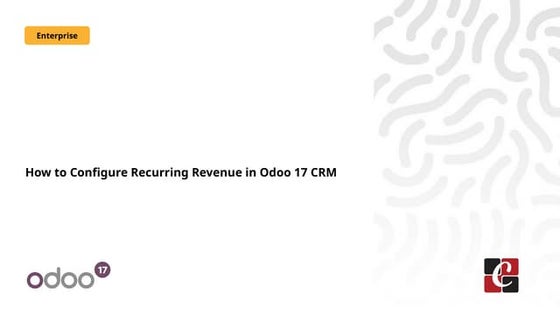



How to Configure Recurring Revenue in Odoo 17 CRMCeline George
Ěý
This slide will represent how to configure Recurring revenue. Recurring revenue are the income generated at a particular interval. Typically, the interval can be monthly, yearly, or we can customize the intervals for a product or service based on its subscription or contract. How to Configure Deliver Content by Email in Odoo 18 Sales



How to Configure Deliver Content by Email in Odoo 18 SalesCeline George
Ěý
In this slide, we’ll discuss on how to configure proforma invoice in Odoo 18 Sales module. A proforma invoice is a preliminary invoice that serves as a commercial document issued by a seller to a buyer.ASP.NET Interview Questions PDF By ScholarHat



ASP.NET Interview Questions PDF By ScholarHatScholarhat
Ěý
ASP.NET Interview Questions PDF By ScholarHatFunctional Muscle Testing of Facial Muscles.pdf



Functional Muscle Testing of Facial Muscles.pdfSamarHosni3
Ěý
Functional Muscle Testing of Facial Muscles.pdfHannah Borhan and Pietro Gagliardi OECD present 'From classroom to community ...



Hannah Borhan and Pietro Gagliardi OECD present 'From classroom to community ...EduSkills OECD
Ěý
Hannah Borhan, Research Assistant, OECD Education and Skills Directorate and Pietro Gagliardi, Policy Analyst, OECD Public Governance Directorate present at the OECD webinar 'From classroom to community engagement: Promoting active citizenship among young people" on 25 February 2025. You can find the recording of the webinar on the website https://oecdedutoday.com/webinars/
Comprehensive Guide to Antibiotics & Beta-Lactam Antibiotics.pptx



Comprehensive Guide to Antibiotics & Beta-Lactam Antibiotics.pptxSamruddhi Khonde
Ěý
📢 Comprehensive Guide to Antibiotics & Beta-Lactam Antibiotics
🔬 Antibiotics have revolutionized medicine, playing a crucial role in combating bacterial infections. Among them, Beta-Lactam antibiotics remain the most widely used class due to their effectiveness against Gram-positive and Gram-negative bacteria. This guide provides a detailed overview of their history, classification, chemical structures, mode of action, resistance mechanisms, SAR, and clinical applications.
📌 What You’ll Learn in This Presentation
âś… History & Evolution of Antibiotics
âś… Cell Wall Structure of Gram-Positive & Gram-Negative Bacteria
âś… Beta-Lactam Antibiotics: Classification & Subtypes
âś… Penicillins, Cephalosporins, Carbapenems & Monobactams
âś… Mode of Action (MOA) & Structure-Activity Relationship (SAR)
âś… Beta-Lactamase Inhibitors & Resistance Mechanisms
âś… Clinical Applications & Challenges.
🚀 Why You Should Check This Out?
Essential for pharmacy, medical & life sciences students.
Provides insights into antibiotic resistance & pharmaceutical trends.
Useful for healthcare professionals & researchers in drug discovery.
👉 Swipe through & explore the world of antibiotics today!
đź”” Like, Share & Follow for more in-depth pharma insights!Blind spots in AI and Formulation Science, IFPAC 2025.pdf



Blind spots in AI and Formulation Science, IFPAC 2025.pdfAjaz Hussain
Ěý
The intersection of AI and pharmaceutical formulation science highlights significant blind spots—systemic gaps in pharmaceutical development, regulatory oversight, quality assurance, and the ethical use of AI—that could jeopardize patient safety and undermine public trust. To move forward effectively, we must address these normalized blind spots, which may arise from outdated assumptions, errors, gaps in previous knowledge, and biases in language or regulatory inertia. This is essential to ensure that AI and formulation science are developed as tools for patient-centered and ethical healthcare.How to create security group category in Odoo 17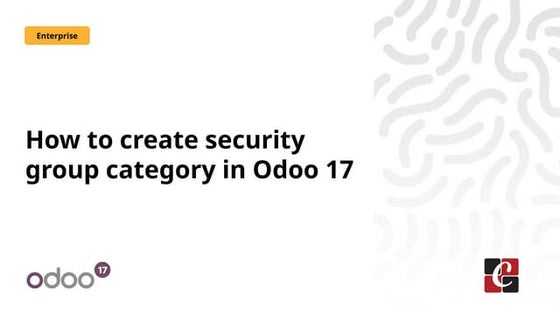



How to create security group category in Odoo 17Celine George
Ěý
This slide will represent the creation of security group category in odoo 17. Security groups are essential for managing user access and permissions across different modules. Creating a security group category helps to organize related user groups and streamline permission settings within a specific module or functionality.Dr. Ansari Khurshid Ahmed- Factors affecting Validity of a Test.pptx



Dr. Ansari Khurshid Ahmed- Factors affecting Validity of a Test.pptxKhurshid Ahmed Ansari
Ěý
Validity is an important characteristic of a test. A test having low validity is of little use. Validity is the accuracy with which a test measures whatever it is supposed to measure. Validity can be low, moderate or high. There are many factors which affect the validity of a test. If these factors are controlled, then the validity of the test can be maintained to a high level. In the power point presentation, factors affecting validity are discussed with the help of concrete examples.RRB ALP CBT 2 Mechanic Motor Vehicle Question Paper (MMV Exam MCQ)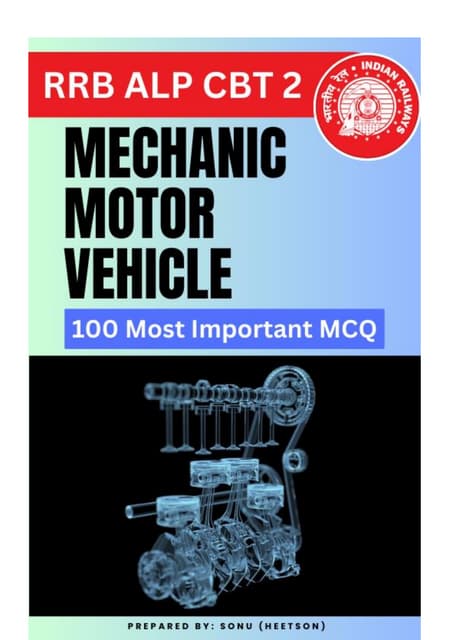



RRB ALP CBT 2 Mechanic Motor Vehicle Question Paper (MMV Exam MCQ)SONU HEETSON
Ěý
RRB ALP CBT 2 Mechanic Motor Vehicle Question Paper. MMV MCQ PDF Free Download for Railway Assistant Loco Pilot Exam.Azure Data Engineer Interview Questions By ScholarHat



Azure Data Engineer Interview Questions By ScholarHatScholarhat
Ěý
Azure Data Engineer Interview Questions By ScholarHatFull-Stack .NET Developer Interview Questions PDF By ScholarHat



Full-Stack .NET Developer Interview Questions PDF By ScholarHatScholarhat
Ěý
Full-Stack .NET Developer Interview Questions PDF By ScholarHatFACILITIES OF REGION 3 - ANNE
- 1. FACILITIES • Region III is an important trading center and transportation terminal for products. Land travel is facilitated by a network of well-paved and extensive highways and roads linking all municipalities within the region. There are two international airports in the region: Clark International Airport (now Diosdado Macapagal International Airport) and Subic International Airport. Port facilities facilitate trade with other areas in the Asia-Pacific region such as Hongkong, China, Taiwan, Singapore, Malaysia and Thailand.
- 2. • Central Luzon is well provided with communication facilities. Its provinces have adequate supply of electricity and potable water. Big markets, recreational facilities, and educational and financial institutions service the needs of the populace.
- 3. LAND USE AND FORESTRY • Region III covers a total land area of 2,147,036 hectares. Of this, 1,204,649 hectares are alienable & disposable lands (A&D) and 942,387 hectares are forest lands. Forty-one percent (41%) of the A&D lands are agricultural plains, with rice as the major crop. The region also produces corn, banana, fruits, and vegetables. • Forest land comprises 43.89% of the region’s total land area. Based on the 2011 Philippine Forestry Statistics, the region has a total forest cover of 589,495 hectares, mostly concentrated in the provinces of Aurora and Zambales. • As of 2012, a total of 120 Community-Based Forest Management (CBFM) Agreements have been issued by the DENR in Region 3 placing under community stewardship 66,822.63 hectares of forestland, benefitting 120 people’s organizations and 10,454 households.
- 4. • The CBFM is a government strategy which “gives the management of forests back to the people.” It offers long-term security of tenure to partner-communities and promotes an integrated approach to sustainable forest resource management. • The Region also implements the National Greening Program (NGP), a flagship program of President Benigno S. Aquino III which aims to plant 1.5 billion trees in 1.5 million hectares of denuded areas in the country from 2011-2016. • In 2012 alone, Region 3 was able to rehabilitate 15,751 hectares of open and denuded lands through massive tree planting involving business and industry groups, socio-civic and people’s organizations, academe and other government agencies, including media and faith- based organizations.
- 5. Land Management Service • Promoting Social Equity by Giving Public Agricultural Lands to the Rural Masses • Introduction of Cadastral Survey - cadastral surveying, a public land survey that covers an extensive area, usually an entire municipality, subdividing the same into parcels for purposes of public land distribution
- 6. • Amendment of Act 926 • Enactment of Commonwealth Act No. 141 • Post war efforts to fast track land distribution • Devolution of functions
- 7. Improved Basic Education Achievement Rates 1. Provision of educational facilities that include classrooms with the attendant facilities, textbooks, computer sets at the elementary and secondary levels. 2. Skills Training cum Classroom Construction 3. Financial assistance and scholarship to deserving poor students. 4. Early childhood care and development. 5. Elementary Science and Math Centers Project.
- 8. Relevant Technical-Vocational Education and Training Programs (TVET) 1. Intensified Social Marketing and Advocacy Program of TVET at the enterprise and community level 2. Strict implementation of the TESDA Quality Monitoring System 3. Re-design of TVET scholarship programs for efficiency and relevance 4. Development of practical and relevant training modules for more effective results based on TVET graduates’ employability 5. Annual tracking of TVET Program graduates and evaluation for its continuing relevance and flexibility in the local and global labor market
- 9. Improved Access to Health Services 1. Establishment of Botica ng Barangay and expansion of the service outlets of Gamot na Mabisa at Abot- Mabisa at Abot-Kaya (GMA 50) Kaya (GMA 50). 2. Monitoring and Testing of Water Potability.








